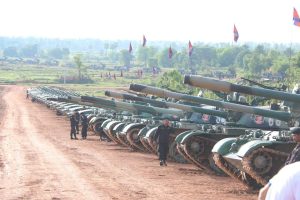China is employing joint military exercises as a foreign policy tool to convey its friendship and strengthen military ties with neighboring nations amid intensifying strategic competition with the United States in the Asia-Pacific region. This approach is driven by one of Beijing`s primary concerns: the potential for its neighbors to side with the United States against China at critical moments.
While being surrounded by about 20 countries on its land and maritime borders, China lacks any sworn allies, aside from North Korea. Meanwhile the United States, despite being geographically distant from the region, has several allies near China’s borders.
Recently, Washington has been increasing its military presence in the Asia-Pacific region through frequent joint military exercises, high-level visits, arms trade, military assistance to allies and partners, and cooperation on defense technology. As an example, the United States has announced plans to establish a presence at four military bases in the Philippines, in addition to its five bases covered by a 2014 agreement. The additional bases reportedly include ones in the north of the Philippines, close to Taiwan. Additionally, the United States conducted the largest-ever joint military exercise with its treaty ally in the Philippines, involving more than 17,600 military personnel.
In response, the Chinese embassy in Manila has raised objections, saying that U.S. access to additional military bases is indicative of a larger U.S. strategy aimed at encircling and containing China. Given the escalating tensions in the Taiwan Strait, China is particularly sensitive to perceived U.S. military besiegement, fueled by the establishment of additional military bases and troops deployments in close proximity to China. Beijing suspects that the United States is colluding with neighboring nations to create a strategic chokehold around China.
As a response to what it perceives as U.S. attempts to militarily besiege China, Beijing actively engages in its own joint military exercises with Southeast Asian nations. These drills serve as a diplomatic tool allowing China to forge closer defense ties with neighbors. An example of this is China’s upcoming multinational joint exercise named Aman Youyi (combining the Malay word for “peace” and the Chinese word for “friendship”). Aman Youyi will involve five Southeast Asian nations: Cambodia, Laos, Malaysia, Thailand, and Vietnam later this year. The precise date, scope, and nature of the drills are still under discussion.
The Global Times, a Chinese state-owned tabloid, highlighted that China seeks to increase its joint military drills with Southeast Asian nations as a response to the U.S. increasing exercises with its allies the Philippines, Japan, and South Korea in the Asia-Pacific region.
In China’s military strategy, international joint military exercises are considered an integral component of overseas use of military power, part of what strategists call “non-war military operations.” In this regard, bilateral and multinational joint drills are commonly referred to as the “soft use” of “hard power” on the global stage. The Science of Military Strategy, a prominent publication outlining Chinese military strategies and doctrines, emphasizes the significance of conducting joint exercises with foreign militaries as a means to “deepen mutual understanding with friendly nations, and enhance mutual political and military trust.” To that end, China has been stepping up such drills with its neighbors, particularly in Southeast Asia.
The Chinese People’s Liberation Army (PLA) recently conducted the Friendship Shield 2023 joint military drills with the Lao People’s Armed Forces (LPAF) at the LPAF Kommadam Academy, in May 2023. A senior Chinese officer emphasized the importance of this joint training exercise in terms of deepening mutual trust and enhancing interoperability between two militaries.
Furthermore, in April, the People’s Liberation Army carried out a joint patrol with Vietnam in the Beibu Gulf, marking the inaugural meeting between the senior leaders from two countries’ maritime law enforcement agencies. China also held a joint maritime exercise with Singapore in late April
In late March and early April, the PLA carried out a joint military drill with Cambodia called Golden Dragon 2023. Cambodia is among the countries that have maintained historically strong relationships with China. Vice Admiral Wei Wenhui, the deputy commander of the PLA Southern Theater Command, highlighted that the China-Cambodia joint exercise served as crucial platform for exchanges, mutual learning and joint training between the two militaries. It also played a vital role in “achieving the expected purpose of consolidating the profound friendship and deepening security cooperation.”
Beijing generally uses military exercises for a wide variety of reasons: from military training purposes – improving the quality of military performances and combat readiness and preparedness, and testing new weapons – to broader foreign policy objectives. With tensions continuing to rise in the Taiwan Strait, Beijing’s primary objective is to make sure its neighbors are not aligned with the United States against China by reassuring them of its friendship through various diplomatic measures, including joint military exercises.

































